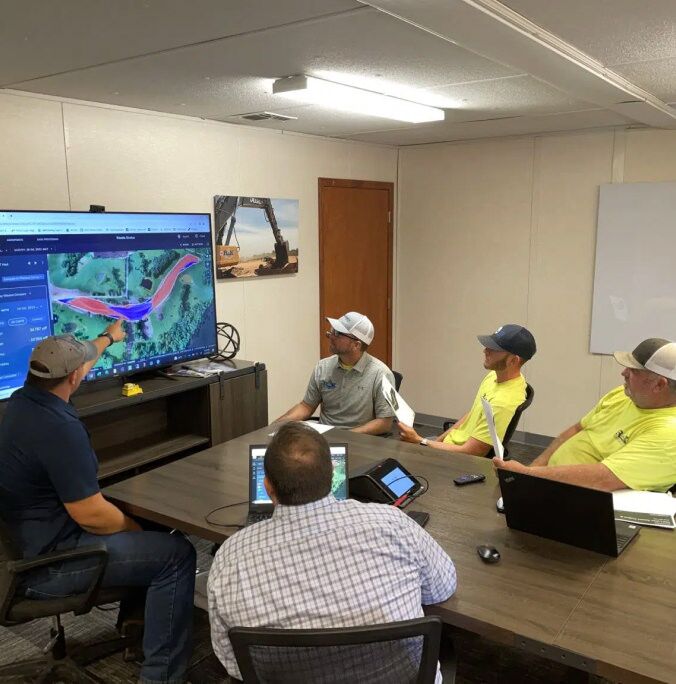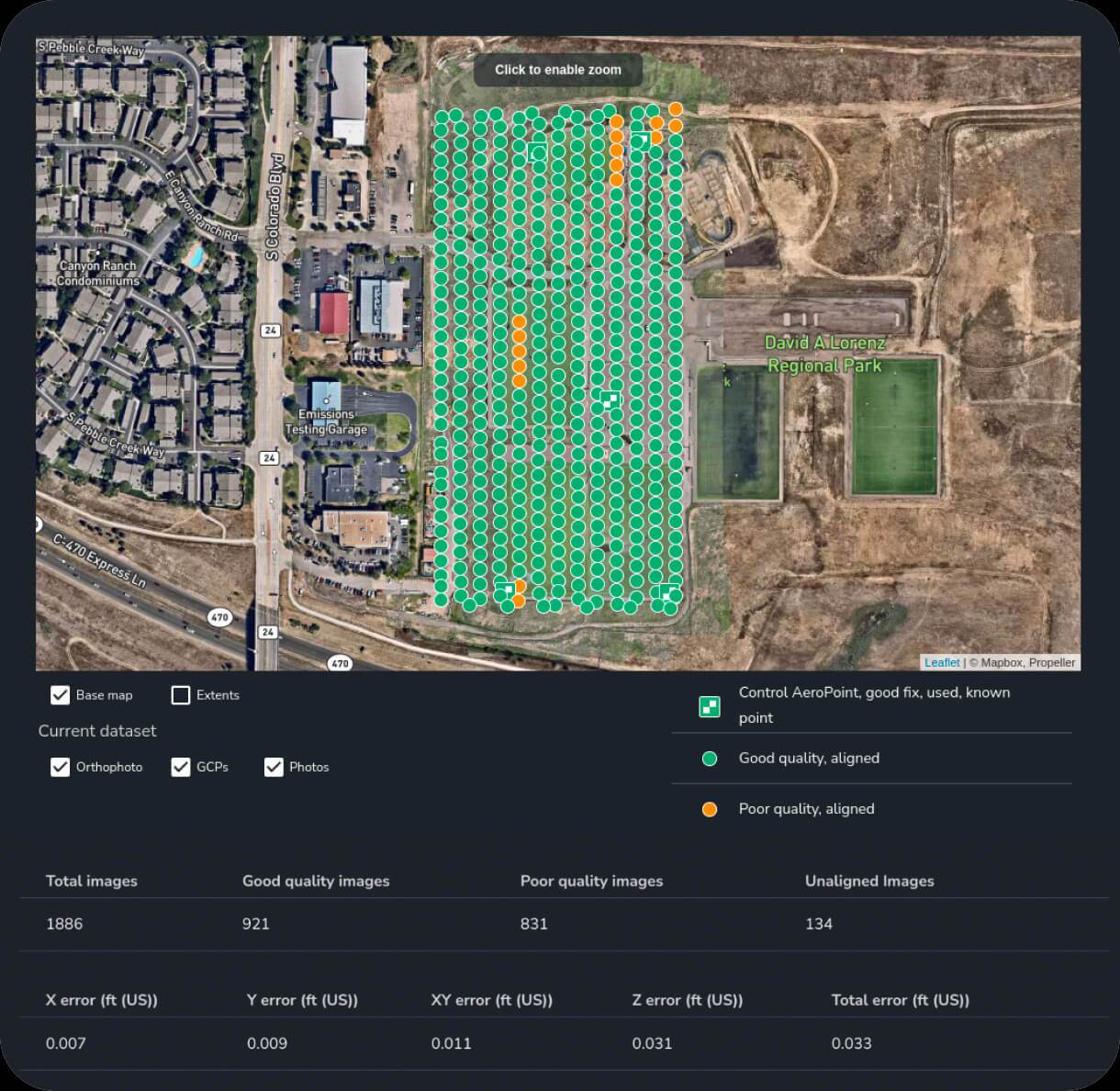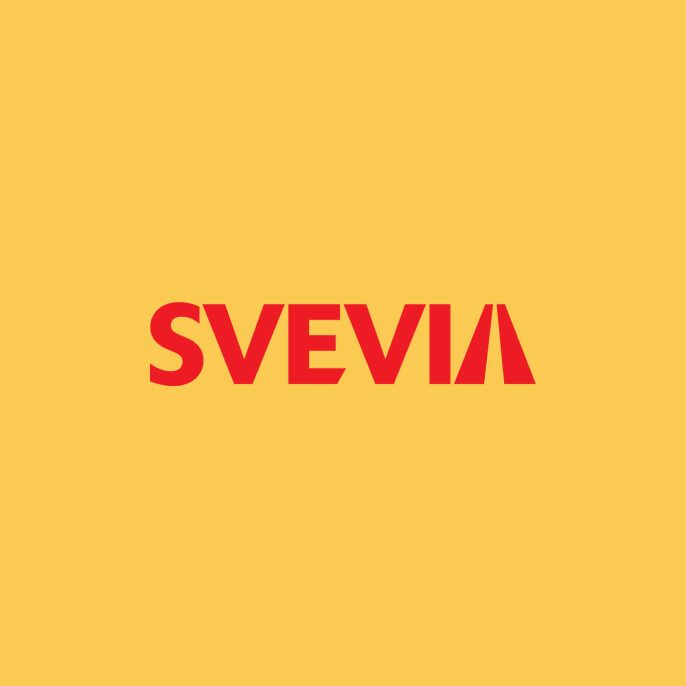“I think the datasets speak for themselves. It’s nothing that you have to bring anyone onboard with. It’s data that’s intrinsically and obviously valuable.”

It takes a lot of technical expertise to turn survey data into accurate and realistic 3D maps. Our photogrammetry processing pipeline, managed by a team of geospatial experts, makes drone data accuracy repeatable and predictable — no matter how many datasets you’re juggling at once.
We’ll process your data in the coordinate system you need, whether it’s global or local, and alert you when it’s ready.
Survey as much as you need – whether it’s one survey or ten at the same time, we’ve got you covered.
Get verifiable survey-grade results using AeroPoints and a Propeller-recommended drone. Review a detailed report to verify accuracy.
Review a detailed photogrammetry processing report to verify accuracy and give your approval.
Simply upload your drone data and we’ll do the rest. We’ll build a high-resolution terrain model, point cloud, orthophoto, and other survey deliverables in a matter of hours. Whether you’re on-site, in the office, or working from home, our photogrammetry processing services are just an upload away.
We work as an extension of your survey team, using a mix of automated QA and human supervision to ensure historical consistency between datasets.
No matter the time or day, you can talk to one of our geospatial experts. From troubleshooting, giving advice, or simply answering your questions, we’re here to help you get the answers you need to keep going.
Choose from our database of over 5,000 published CRS, or upload a local CRS of your own. No after-the-fact transformation needed.
Upload your images, ground control, checkpoints, and GPS files into Propeller, and we’ll do the rest
Customize your terrain filtering and QA settings so we know your preferences.
We tie your 3D model down to your site’s ground control points.
Your images are aligned and stitched together.
We produce the 3D point cloud and validate its data.
We use the point cloud to generate surface and elevation models to create the site’s orthophoto, an aerial image that’s been geometrically corrected.
The site model and surface undergo a final validation.
You’ll be notified that your dataset is ready to explore.
Along with your processed dataset, we’ll send over a summary of your image quality, ground control accuracy, and survey metadata.

Whether you’re on-site, in the office, or working from home, our photogrammetry processing services are just a message away.

“I think the datasets speak for themselves. It’s nothing that you have to bring anyone onboard with. It’s data that’s intrinsically and obviously valuable.”

“Propeller’s outsourced processing gets us data back much faster, and the accuracy is great. The whole process is so easy, I could almost have my kid do it”.
Photogrammetry is the science of collecting physical information from 2D photos, which are often aerial images captured by drones. By combining enough overlapping images of the same features, photogrammetry software can generate photorealistic 3D representations of topographic surfaces.
Surveying and GIS professionals use photogrammetry to create 3D maps and models for use in construction, waste management, mining, and aggregates’ workflows. Read how drone photos turn into 3D surveys.
PPK workflow uses an RTK drone to collect images and positional information, paired with our high-precision smart ground control points called AeroPoints. Instead of relying on real-time exchange and risking signal loss, the actual processing of that data occurs after the drone flight is complete. PPK stands for “post-processing kinematic.”
While the drone is busy in the air, an AeroPoint on the ground also continuously records precise positional information, with more accurate triangulation. Post-flight, the GPS data from both drone and AP are matched using timestamps on the photos. The more accurate positional information from the base is used to course-correct the data.
We spend a lot of time searching through images for poorly-placed or hard-to-see ground control points, correcting user-input errors (like coordinate systems or missing GPS files), and resolving issues caused by poor data collection practices. Using a recommended drone with AeroPoints and following our best practices for data capture significantly improve processing completion times.
There are different types of output GPS files, but we process data in the same way. The biggest difference is processing time for fixed-wing drone surveys due to file size; if you use a 42MP camera to capture a very large area, it can result in an enormous dataset of images, sometimes hundreds of gigapixels.
Recommended drones are integrated with the entire Propeller ecosystem. We’re able to to provide full support and training, and customers using recommended drones can utilize our PPK workflow.
Supported drones are fully compatible with our software and we can process their high-accuracy data, but they don’t utilize the complete PPK workflow. They often have difficulty capturing data consistently and accurately.
Non-supported drones generally aren’t meant for capturing data with survey-grade accuracy. We can process the data, but can only promise a relative accuracy (not absolute), that is equal to 1-2x the provided image Ground Sample Distance (GSD). Given the variability of imagery between various drones, we can’t specify any accuracy comparison metrics.
Propeller’s GPS experts have worked alongside select drone manufacturers to ensure that their L1/L2 GNSS receivers work seamlessly with Propeller’s own developed technology to bring easy, affordable, and highly accurate maps to the wider commercial drone industry. Propeller uses Agisoft Metashape as part of our imagery pipeline to realise survey-grade accuracy
If you are using one of our recommended drones and are following best practices, the Propeller PPK solution can deliver survey-grade accuracy to within 1/10ft (3cm).
In terms of operational workflows it couldn’t get any simpler.
Once the drone finishes its flight and automatically returns to your location, upload your data to Propeller and let us do the processing for you.
There’s no need to download any software. No need to tweak or preprocess imagery or site data. In 24 hours, your 3D site survey is rendered with survey-grade accuracy and you can start measuring and managing your site and your assets immediately.